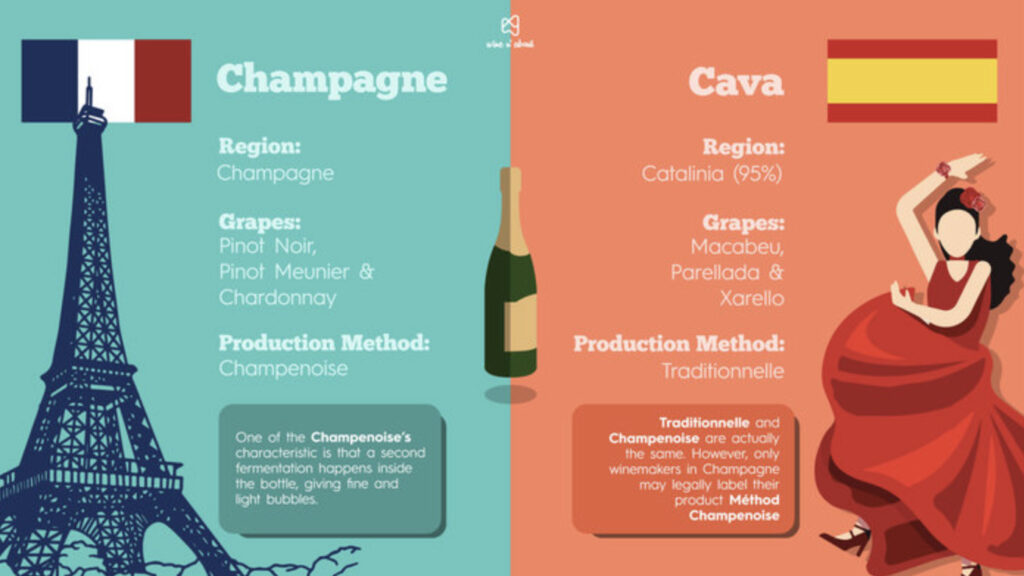When it comes to sparkling wine, Champagne and Cava are two of the most celebrated options available. Both offer effervescence and elegance, making them popular choices for celebrations and special occasions. However, they differ significantly in terms of origin, production methods, flavor profiles, and price. In this blog post, we’ll explore the key differences between Champagne and Cava to help you appreciate each for its unique qualities.
1. Origin: France vs. Spain
The most notable difference between Champagne and Cava is their origin. Champagne comes exclusively from the Champagne region in northeastern France. The region’s unique climate and chalky soils are essential in creating the distinct characteristics of Champagne. By law, only sparkling wines produced in this region and under specific regulations can bear the name “Champagne.”
Cava, on the other hand, is produced primarily in the Catalonia region of Spain, with the town of Sant Sadurní d’Anoia serving as its heart. Although Cava can be made in other regions of Spain, Catalonia is where most Cava production takes place. The Mediterranean climate and diverse soils of this region contribute to Cava’s distinctive profile.
2. Grape Varieties
The grape varieties used to make Champagne and Cava are another major point of difference. Champagne is typically made from a blend of three main grape varieties: Chardonnay, Pinot Noir, and Pinot Meunier. Each of these grapes adds complexity and balance to the final product, with Chardonnay offering finesse, Pinot Noir providing structure, and Pinot Meunier adding fruitiness.
Cava, however, is made from indigenous Spanish grape varieties, primarily Macabeo, Xarel·lo, and Parellada. These grapes give Cava its characteristic freshness and slightly earthy flavor profile. Some Cavas, particularly premium ones, may also include international varieties like Chardonnay or Pinot Noir, but the traditional grapes remain the foundation of Cava production.
3. Production Method: Traditional Method for Both
One similarity between Champagne and Cava is that both are produced using the traditional method (méthode champenoise in France, método tradicional in Spain). This method involves a secondary fermentation in the bottle, where the wine gains its bubbles. However, while the process is the same, the length of aging can vary significantly between the two.
Champagne often undergoes a longer aging process, particularly for vintage or prestige cuvées. The minimum aging requirement for non-vintage Champagne is 15 months, with many premium Champagnes aging for much longer. This extended aging on the lees (dead yeast cells) contributes to Champagne’s complexity, adding rich, toasty, and brioche-like flavors.
Cava’s aging requirements are shorter, with non-vintage Cava requiring a minimum of 9 months of aging. While there are longer-aged Cavas, such as Reserva (15 months) and Gran Reserva (30 months), they generally do not reach the extended aging periods common in Champagne. As a result, Cava tends to have a fresher, fruitier profile with less emphasis on the toasty or yeasty notes that are prominent in Champagne.
4. Flavor Profile and Style
The flavor profiles of Champagne and Cava reflect their different grape varieties, climates, and aging processes. Champagne is known for its elegance and complexity, often featuring flavors of citrus, apple, pear, and brioche, with a fine mousse (bubble structure) and a long, lingering finish. The cooler climate of the Champagne region imparts a higher acidity, which balances the richness of the wine.
Cava, in contrast, is generally lighter and more approachable. Its flavor profile is typically more fruit-forward, with notes of green apple, citrus, and almond. The bubbles in Cava are often slightly coarser than those in Champagne, and the overall character of the wine is more straightforward and fresh. Some premium Cavas, especially those with longer aging, can develop more complexity and a creamier texture, but they still tend to be less intricate than Champagne.
5. Price Point
One of the key differences that consumers often notice is the price. Champagne, due to its labor-intensive production process, long aging periods, and strict regional regulations, is generally more expensive than Cava. Even entry-level Champagnes can be relatively costly, while premium bottles can command very high prices.
Cava, on the other hand, is known for offering excellent value for money. It is typically more affordable than Champagne, making it a popular choice for those seeking quality sparkling wine at a reasonable price. The lower cost of production in Spain, combined with shorter aging requirements, allows Cava producers to offer their wines at a more accessible price point.
6. Occasions and Pairings
Both Champagne and Cava are versatile and can be enjoyed on various occasions. Champagne, with its complex and refined character, is often reserved for special celebrations, fine dining, and sophisticated pairings such as with oysters, caviar, or creamy cheeses. Its acidity and richness make it a great match for a wide range of dishes, from appetizers to desserts.
Cava, with its fresh and lively profile, is perfect for casual gatherings, brunches, or as an aperitif. It pairs well with tapas, seafood, light salads, and even fried foods, thanks to its crisp acidity. Cava’s affordability also makes it a go-to choice for larger celebrations where multiple bottles might be needed.
Conclusion: Champagne or Cava?
Ultimately, the choice between Champagne and Cava depends on the occasion, your taste preferences, and your budget. Champagne offers a luxurious and complex experience, ideal for special moments and sophisticated pairings. Cava, with its approachable and refreshing style, provides a delightful and budget-friendly option for more casual enjoyment. Both have their unique charm, and understanding the differences allows you to appreciate each for what it brings to the table.
So, whether you’re toasting to a milestone or simply enjoying a glass with friends, both Champagne and Cava offer a sparkling way to celebrate life’s moments. Cheers!
